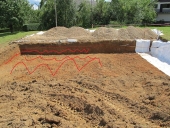Hi John,
thanks for weighing in. So I'm doing a very dry, fluffy mix trying to emulate wood fibre insulation boards with what I have available.
There is just enough lime to bond the wood fibres together but leaving loads of air pockets in between.
I made a vid to explain better what I'm trying:
https://streamable.com/5ocwpr
So far I'm pretty happy with it. It's drying fast because we have 30 degrees at the moment. I'm sure it insulates less than industrial products, but that doesnt bother me.
Have a look at the vid, let me know what you think.
Cheers
Max
John C Daley wrote:I have had nil experience with those products, together.
BUT, I have plenty experience with the situation you are dealing with and earth building.
Lime is used as an additive to clay to create a plaster that breaths.
Wood shavings are not high on the list of insulating product efficiency.
Hemp crete works best as a very thick medium.
Nothing you appear to be proposing will be of any benefit for insulating purposes.
What are you building and perhaps more information will help us?
I believe more modern materials may give you a better and faster outcome, since limecrete / plaster takes ages to dry.







